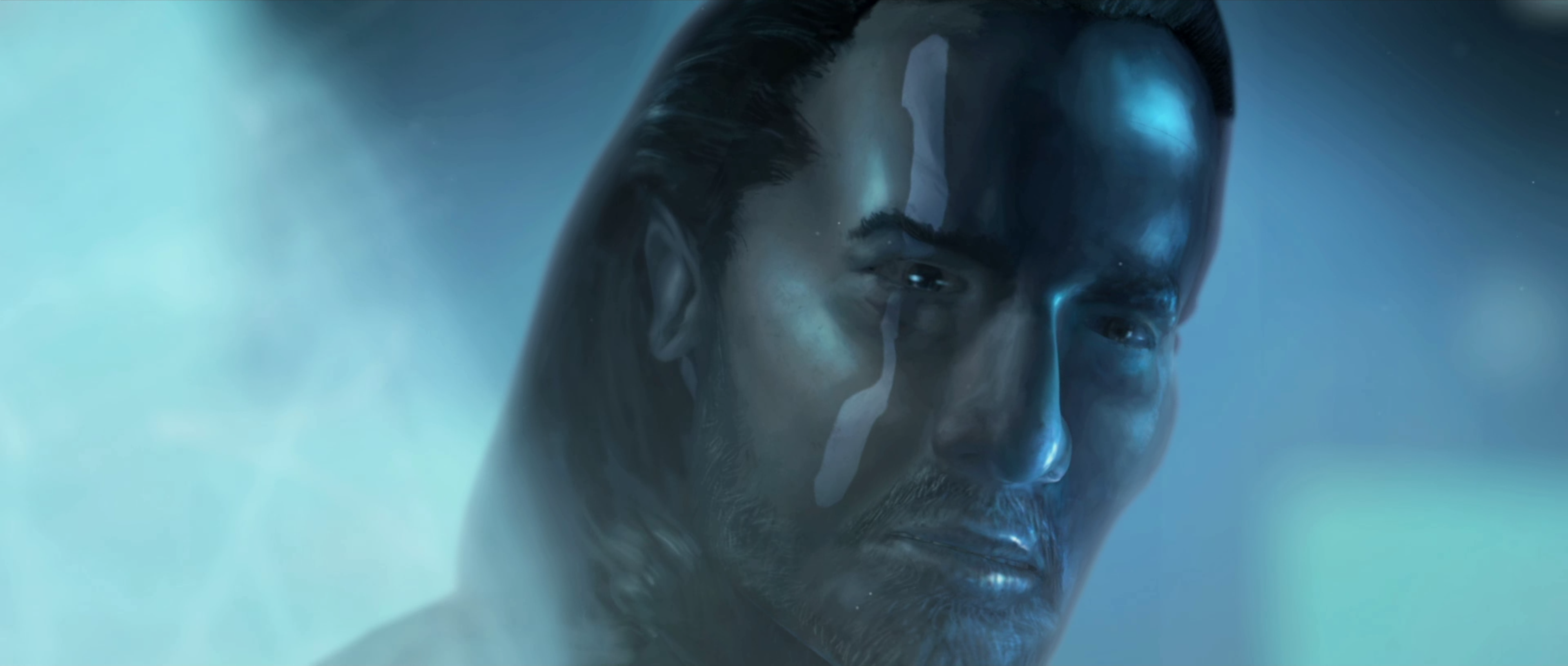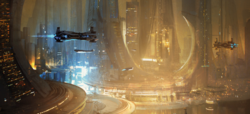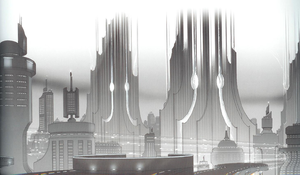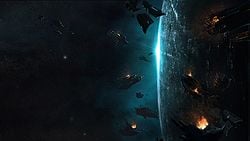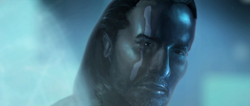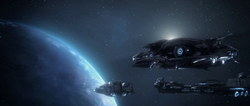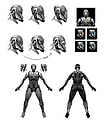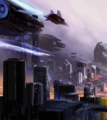Ancestors
From Halopedia, the Halo wiki
| Ancestors | |
|---|---|
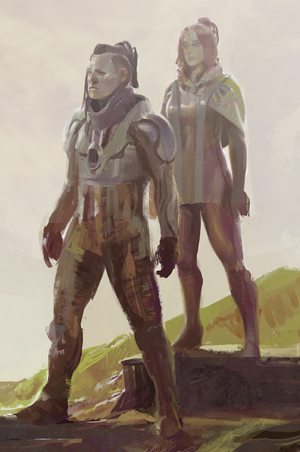 Ancient humans Yprin and Forthencho.[1] Ancient humans Yprin and Forthencho.[1]
| |
| Empire overview | |
|
Type: |
Interstellar empire |
| Societal overview | |
|
Capital: |
|
|
Tier 1 | |
| Historical overview | |
|
Formation: |
c. 150,000 BCE |
|
Dissolution: |
|
- "Once, we were one great race, united in power and concerted in our goals..."
- — Forthencho[2]
The Ancestors,[3][4] scientifically designated archeohomina,[5] and commonly referred to as ancient humanity,[6][7] were a prehistoric, technologically advanced civilization of the human species that rose to preeminence in the Milky Way galaxy by approximately 150,000 BCE. Having first achieved interstellar travel over a million years earlier and colonized planets across the Orion Arm toward the galactic border, humans became a major political and military power rivaling the Forerunners; indeed, the Didact considered them the second greatest military power and the latest challenge to Forerunner influence. Over a hundred thousand years later, the Librarian would tell John-117 that they were the greatest threat ever faced by the Forerunners.[8] Members of the most predominant human species of this era were on average larger, stronger, and significantly more intelligent than modern humans.[6] This civilization allied with the contemporary San'Shyuum and later waged war against the Flood, only to come into conflict with the Forerunners; they ultimately suffered a disastrous defeat against the Forerunners and were subsequently regressed into hunter-gatherers, confined to their ancient homeworld.
History[edit]
Origin and rise[edit]
Having presumably evolved and achieved civilization on Earth, originally known as "Erda" or "Erde-Tyrene",[9] humanity first became a spacefaring civilization at some point prior to 1,100,000 BCE. These early humans settled on numerous worlds along the galactic margin; these regions would be targeted by the Flood's initial assault over a million years later.[10] Early in their history, long before encountering the Forerunners, humanity underwent a series of technological dark ages, which left their populations scattered across many worlds and resulted in the loss of most of their records, including the knowledge of Earth being their potential original homeworld. It was not until much later when scientists led by Yprin Yprikushma traced humanity's potential origin to Earth.[9] Around 150,000 BCE humanity moved their civilization outward along the Orion Arm, possibly to flee Forerunner control.[11] They first settled in and built up population centers in two star systems dozens of lightyears away from Sol before stringing outposts together across nearly thirty thousand lightyears toward the galactic margin of the galaxy.[12]
After recovering from their dark ages, humanity made the former Precursor world Charum Hakkor their capital, to be close to one of the greatest collections of Precursor structures.[13] Humanity also formed an alliance with the San'Shyuum species in order to gain access to their advanced technology.[14] At their height, humanity's technological advancement nearly rivaled that of the Forerunners.[15]
War[edit]
- Main article: Human-Forerunner wars

This civilization encountered the Flood by 108,764 BCE at the latest and went to war against the parasite after discovering its true nature. After losing many planets to the Flood, humanity desperately invaded a minor sector of the Forerunners' ecumene, ostensibly in an attempt to seize new territory to replace the worlds they had lost, though at least some instances of this seeming aggression were in fact humanity sterilizing worlds where Flood infestation had already taken hold. Nevertheless, the Forerunners responded violently to this aggression and waged war with the humans and their San'Shyuum allies. The resulting conflicts lasted for a thousand years.[8]
In 107,564 BCE, forty years before the last conflict between humanity and the Forerunners, a human expeditionary group encountered an ancient being held in hibernation on a planet near the galaxy's edges. Under Yprin Yprikushma's orders, this being, known as the Primordial, was placed in a stasis capsule and transported to Charum Hakkor for study.[9] Human researchers found a way to communicate with the entity, asking in vain for answers to various scientific or moral questions, receiving no useful responses.[16] Instead, the being revealed disconcerting truths about humanity's origins; this was believed by some to have caused the demoralization of human culture and thus contributed to their defeat against the Forerunners.[9] They also inquired the Primordial about the Flood; the answers they received were so traumatizing that many committed suicide.[16]
After a certain point, the Flood's rampage throughout human territory stopped. The Flood no longer infected humans and instead began to rapidly die out, with both humans and Forerunners sterilizing the remaining infestations.[17] Based on this pattern, the Forerunners concluded that humanity had discovered a cure for the Flood: according to Forerunner records, the humans sacrificed a third of their total population, implanting them with destructive, artificially programmed genes used to target the Flood on a genetic level. In reality, however, the Flood had receded by its own volition after the sacrifice; no truly functioning cure was ever created or used by humanity,[18] though both Forerunners and humans themselves remained under such illusion.[19]
Stretched thin due to fighting two wars at once, the humans were finally driven to their capital of Charum Hakkor. After holding off for fifty-three years they were defeated at the hands of the Forerunners, led by the Didact.[20] Before the fall of Charum Hakkor some humans suggested they should draw out the Flood and use it against the Forerunners. However, this strategy was denied, as the human leadership chose to face defeat rather than allow the Flood to spread.[21]
Downfall[edit]
As punishment for defying the Forerunners, nearly all of humanity was wiped out and the remnants and technological achievements of their civilization were extirpated. Furthermore, the surviving humans were subjected to a process of biological devolution;[22][23] live humans were forced to consciously experience an artificially induced reversion of their evolutionary process, to the point of their bodies transforming to their ancestral forms and eventually losing intelligence.[24] The remnants of the human species were exiled to Earth, where they were overseen by the Librarian; while many Forerunners wanted to see humanity exterminated, the Librarian had always been considered their greatest protector.[25] In only a thousand years, humanity recovered many of their prior forms, along with many new ones, due to the assistance of the Librarian and her geas, as well as unknown factors not even the Librarian and her Lifeworkers could explain.[26] Over twenty human species made recovery and formed separate populations on Earth,[22] including the hamanush, k'tamanush, b'ashamanush, and chamanush.[23] This meddling was noted to have considerably distorted Earth's natural fossil records.[22]
The Forerunner victory proved disastrous for the galaxy, as the humans destroyed all their research data and physical evidence concerning the Flood, including their supposed cure. Bornstellar Makes Eternal Lasting speculated it may have been humanity's last act of revenge to leave the Forerunners unprepared to face the incoming threat that led to the firing of the Halo Array.[20] The last human survivors on Charum Hakkor were subjected to thorough analysis and experimentation to discover their supposed Flood immunity; eventually, their patterns were extracted by Composers and archived in machine storage, where the human essences would be incessantly scoured for a cure for thousands of years.[27]
The Librarian and Didact later learned that humanity had never developed a cure or a way to fend off the Flood. As the remnant of the Precursors, the Flood sought to punish the Forerunners for destroying them and ensure that humanity obtained the Mantle. When the Forerunners retaliated against the humans for invading Forerunner worlds, the Flood predicted that the Forerunners would try to exterminate humanity. Of its own volition, the Flood abruptly receded from human territory, knowing that the humans would temporarily rebound and thus unknowingly deceive the Forerunners into thinking they may have developed a cure. This caused the Forerunners to restrain themselves from eradicating humanity and preserve a regressed remnant population since they needed living humans to study if their apparent Flood cure was to be found.[28]
Partial recovery[edit]
- Main article: Erde-Tyrene civilization

Forced to start again, the collective human genus tried in vain to reattain their former glory. Some human communities, such as the civilization built around Erde-Tyrene's largest city, Marontik, established wooden cities and steam-powered waterborne vessels nearly nine thousand years later.[23][29] Most humans, however, lived in Tier 7 tribal communities, such as the one that was encountered by the Forerunners during the construction of the portal to the Ark in eastern Africa.[30]
After the activation of the Halo Array, the human civilization regressed once again, and would remain Tier 7 hunter-gatherers for nearly a hundred millennia.
Rediscovery[edit]
For much of humanity's history before the mid-26th century, virtually all artifacts and records of their former civilization had been lost to time. However, in the mid-2550s, after the Human-Covenant War had ended, small but significant discoveries began to trickle in about humanity's powerful past. On Heian, ruins were found resembling a wide variety of human styles, including Greco-Roman, Middle Eastern, and East Asian, with subtle Forerunner themes. The Department of Xenoarchaeological Studies at the University of Edinburgh found the obvious elements of human architecture in the structures puzzling, wondering if their builders borrowed from human architecture or the other way around.[31] The Office of Naval Intelligence discovered one derelict ancient human vessel at Site Yankee-002-G3. The Xeno-Materials Exploitation Group examined the artifact in ONI XENO-MATERIALS EXPLOITATION REPORT 15Y1198 and assessed its tactical capabilities. Their report recommended that further analysis of the ship should be immediately assigned to Project ARC DREAM and noted that an investigation of its weaponry was already underway by a team on AZURE MOON.[5]
Records of prehistoric humanity began to be encountered as well. On Onyx, an artifact referred to as the Bornstellar Relation gave a testimony of the life of the Forerunner Bornstellar Makes Eternal Lasting, including the knowledge that humanity had once been a Tier 1 species.[32] This account was complemented by the testimony of the remains of 343 Guilty Spark, who related to listening scientists about his life as the prehistoric human Chakas.[33][34]
In July 2557, the Spartan-II John-117 encountered an archived personality of the Forerunner known as the Librarian on Requiem. She revealed the times of the ancient human-Forerunner wars to the Spartan, as well as the origins of the mechanical Prometheans, ancient humans who had been the first "conscripts" into the Didact's army during the last years of the Forerunner's war against the Flood. The Librarian further revealed that she had been guiding humanity since their devolution, notably instigating the physical evolution of the select few humans who met the SPARTAN-II program's genetic requirements, as well as the creation of powered armor and even AIs like Cortana, in an attempt to prepare humanity from an unknown threat. The Librarian would call John "the culmination of a thousand lifetimes of planning" though she never got to tell him for what. During this conversation, the Librarian would call ancient humanity the greatest threat ever faced by the Forerunners. As a result, the recently revived Didact sought to finish their destruction with the Composer. John would later share this information with the bridge crew of the UNSC Infinity.[8] At some point, the UNSC would discover some ancient human ruins with knowledge on a dead world, and a shattered starship with a vault full of unknown materials; using technology gathered from both discoveries, the UNSC would create the HELLCAT-class Mjolnir.[35]
In late 2558, 343 Guilty Spark discovered that the Librarian's work on Bastion - which resembled a copy of Earth, the homeworld of humanity - included studies and experimentation on ancient humanity.[36]
The Domain[edit]
After being composed, Forthencho and the Ancestors were sent to the outer boundaries of the Domain. It took the Ancestors tens of thousands of years to adjust, and finally heal their souls, to remember their past and reform themselves into a complete presence within a rift in the Domain's outer boundaries where the Warden Eternal kept them out of the Domain itself. According to Forthencho, this was because being composed had kept the Ancestors from any sort of a human afterlife and instead sent them to the Forerunner one.[37]
While in the outer boundaries of the Domain, the Didact met the composed essences of Forthencho and millions of other Ancestors. After the Didact mentioned the current human race to the Ancestors, they were greatly relieved, revealing that they had not known whether or not their kind had survived. The Didact told the Ancestors everything that he knew about human history, from the firing of the Halo Array to the state of humanity as the Didact found it when he had awakened on Requiem. That humanity had miraculously survived thanks to the Librarian's planning and was once again colonizing the stars caused a wide spectrum of emotion: grief for the enormity of their own loses, and pride for the dogged nature of humanity and the achievements made in their absence. After hearing the story and of the danger of Cortana and the Created, Forthencho and his warriors agreed to ally with the Didact and the other Forerunner essences to free the Domain from Cortana's control.[37] The Ancestors and the Forerunners later attacked the Warden Eternal as a distraction, giving the Didact the chance to destroy the construct.[38]
Following the destruction of the Warden Eternal, the Didact invited the human essences to join the Forerunners in the halls of the Domain.[39][40]
Physiology[edit]
While ancient humans exhibited a range of morphological variation,[41] the ethnic group represented by Forthencho and his bridge crew were remarkably similar in appearance to modern Homo sapiens. They possessed straight to wavy hair textures, thin to full lips, and an overall largely similar facial composition to their modern counterparts. [42] Like modern humans, ancient humans had a range of different body types; for example, Forthencho was tall and muscular while Yprin Yprikushma had a short and stocky build.[43] After meeting Chakas, a Homo sapiens, the Didact was displeased and noted that he was too much like the humans who had murdered his children and nearly destroyed his fleets while he was more pleased with the appearance of Riser, a Florian and a different type of human.[44]
Despite the technological and biological achievements of their descendants, prehistoric humans naturally possessed more body mass and strength[24] and were on average significantly more intelligent than modern humans.[6] The Librarian said that, if not for their encounter with the Flood, prehistoric humanity's gene-plan could have surpassed that of even the Forerunners.[45] After fighting against the Didact for fifty-three years, in the endgame of the human-Forerunner wars, Forthencho had acquired noticeable facial wrinkles. However, he still retained the body mass he possessed in his youth. Given the length of Forthencho's career (at least a thousand years) it can be concluded that ancient humans had much longer lifespans (a record made by 343 Guilty Spark on Reclaimers and specifically John-117 indicated that one of the physiological ailments he possesses is modern humanity's "highly truncated lifespan") than their modern descendants (whether naturally, due to advanced medical science, or a combination of the two), although their lifespans still paled in comparison to those of the Forerunners.[46]
Culture[edit]
Little is known about human culture of this time. According to the Ur-Didact, humanity believed themselves to be the true inheritors of the Mantle of Responsibility, a notion the Forerunners considered heretical.[13] Ironically, the Precursors had intended for humans to inherit the Mantle instead of the Forerunners.[47] Regardless of the pressure on their growing populations and the Flood, humans were also said to be particularly cruel toward other species. Chakas, examining the harvested memories of his ancestors imprinted to him as part of a geas, discovered that they believed in "creating many souls", or expanding their population by conquering and claiming other worlds.[48]
The humans of this time were willing to forge relations and alliances with other sapient species as evidenced by their alliance with the San'Shyuum, who shared their disdain for the Forerunners. This bond deepened over time, with the two species co-inhabiting worlds and creating political and cultural centers along the galactic periphery.[49]
In contrast to the Forerunners, their attentions were drawn to the interleaving of dimensions and weaving of exotic force rather than applications of macro-engineering. They were considered the undisputed masters of scientific synthesis, collaborating with their kind and other sapient species to exploit unique languages, outlooks, and intuitions into a greater whole and more complete understanding of universal principles, a tradition that would endure the long passage of time.[50]
After centuries of constant warfare against the Forerunners and the Flood, human society had become exceedingly militarized; military officials wielded significant decision-making power, some military offices (namely that of the Political and Morale Commander) doubling as political leadership. During the siege of Charum Hakkor, even human children were organized into their defensive guards.[51]
Officers of the ancient human fleets sported various kinds of white facial markings and typically had long hair. Warship crew members wore unadorned, form-fitting suits of body armor, apparently lacking any markings or other features denoting rank,[52] although more elaborate uniforms existed, possibly for ceremonial occasions.[53]
At least some ancient humans practiced a polytheistic religion, including the Lord of Admirals.[54] The Didact noted that humans had a tendency to worship inanimate objects, including Precursor artifacts.[55] In addition, the humans believed in the teaching of Daowa-maadthu, a concept at the center of their beliefs and practices, a reference to the cyclical pattern of trial and growth witnessed over time and often referred to as the roll and tug of the universe on the individual and those within it.[49] This system was exemplified for the ancient humans when a strange powder was discovered aboard mysterious derelict starships that would lead to the devastating civilization-spanning outbreak known as the Flood.[56][49]
The humans, along with their San'Shyuum allies, favored the domesticated Pheru, originating from the planet Faun Hakkor, as pets. The Pheru would also be the first vectors for the Flood.[57]
Technology[edit]
In the decades before the dismantling of their civilization, humans were technological equals of the Forerunners in many areas, likely placing them on Tier 1 on the Forerunner technological achievement scale. This was largely thanks to the efforts of Yprin Yprikushma, who encouraged humanity to study Forerunner technologies encountered in earlier conflicts with Forerunners.[9] Despite this, the Forerunners' technological achievements still overshadowed those of humanity in many fields, including megascale engineering and slipspace technology. For example, the humans were seemingly unable to construct megastructures on the scale of a Halo installation,[58] and their understanding of space-time reconciliation was inferior to that of the Forerunners, who were able to use their superior understanding of slipspace to an advantage by clogging the humans' slipspace channels and slowing their interstellar travel.[59]
Humans of this time used artificial intelligence constructs known as servitors.[60] These robotic intelligences assisted human scientists in reverse-engineering Forerunner technologies during the Forerunner wars, nearly bridging the technological gap between the two civilizations.[9] On Charum Hakkor, the humans built vast constructs supported by the Precursor structures; cities stretching to orbit along orbital arches, described by Bornstellar Makes Eternal Lasting as resembling ivy growing on great trees. In addition, they built energy towers and defense platforms operating at geosynchronous orbit and equigravitation,[61] linked by virtually unbreakable Precursor filaments.[62] Many human worlds were encompassed by vast railway networks, a technological achievement Forthencho took pride in.[58]
Human and Forerunner infantry shared many similar military technologies, including advanced battle armor and directed energy weapons such as various particle rifles. The Didact indicated that at one point humanity (with the help of the San'Shyuum) had developed offensive military technologies that the Didact's warriors had no effective defense against, which enabled them to compensate against the overwhelming numbers of the Forerunner military.[63] Human warships could emit high-intensity energy streams capable of destroying Forerunner ships and sterilizing entire Flood-infected worlds.[52] Examples of ancient human warship types include the prime cruisers and tuned platforms.[64] Ancient human warships were equipped with a weapons system known as a Fibril cutter, alongside weapons superficially similar to particle-beam weapons.[5]
Humans of this era had an understanding of Precursor technology which was sufficient enough to enable them to create a device that could selectively and temporarily open access to a Precursor stasis capsule from outside allowing communication between those outside and the Primordial imprisoned inside it. The device was smooth, oval shaped with three notches in its side.[65]
Sphere of influence[edit]
- Main article: Human colonies
Humanity's empire encompassed at least twenty thousand worlds in a thousand star systems across thirty thousand lightyears[66] of the Milky Way Galaxy.;[67] This is likely before they lost a third of their colonies to the Flood as the Flood had ravaged humanity's colonies for over one thousand years prior to the discovery of the Primordial and the Flood only retreated from the Milky Way Galaxy during the 40 years between the Primordial being discovered by humanity and the final 53-year conflict of the human-Forerunner wars.
Notable individuals[edit]
- Forthencho - Lord of Admirals, head of the human Admiralty.[59] Commanded the last human fleets against the Didact's forces at Charum Hakkor.
- Yprin Yprikushma - Political and Morale Commander and prominent scientist. She contributed significantly to the technological breakthroughs that allowed humanity to hold off against Forerunners.
Gallery[edit]
Lord of Admirals Forthencho, commander of the prehistoric human military, accompanied by human soldiers.
Ancient human ships above Charum Hakkor in Halo Mythos.
An ancient human cruiser found by the Office of Naval Intelligence at Site Yankee-002-G3.
List of appearances[edit]
- Halo: Cryptum (First appearance)
- Halo: Combat Evolved Anniversary
- Terminals (Mentioned only)
- Halo: Primordium
- Halo 4
- Halo: Silentium
- Halo 2: Anniversary (Mentioned only)
- Halo 5: Guardians (Indirect mention)
- Halo Mythos: A Guide to the Story of Halo
- Halo: Renegades (Mentioned only)
- Halo: Point of Light (Mentioned only)
- Halo Infinite (Mentioned only)
- Halo: The Rubicon Protocol (Mentioned only)
- Halo: Epitaph
- Halo: The Machine Breaks (Mentioned only)
- Halo: Empty Throne
- Halo: Tulpamancy
Sources[edit]
- ^ Halo Waypoint :Confirmation of Yprin in Mythos
- ^ Halo: Primordium, page 99
- ^ Halo Encyclopedia (2022 edition), page 10-11
- ^ Halo Waypoint, The New Halo Encyclopedia is Out Today (Retrieved on Mar 11, 2023) [archive]
- ^ a b c Halo: Warfleet, page 14
- ^ a b c Halo Waypoint: Humans
- ^ Canon Fodder: Sustained Glass
- ^ a b c Halo 4, campaign level Reclaimer
- ^ a b c d e f Halo: Primordium, page 237-238
- ^ Halo: Silentium, pages 67-68
- ^ Halo: Cryptum, page 20
- ^ Halo: Silentium, page 42
- ^ a b Halo: Cryptum, page 112
- ^ Halo: Cryptum, page 113
- ^ Halo: Cryptum, page 164
- ^ a b Halo: Cryptum, page 271
- ^ Halo: Silentium, pages 36-37
- ^ Halo: Primordium, page 367
- ^ Halo: Primordium, page 53
- ^ a b Halo: Cryptum, pages 267-272
- ^ Halo: Primordium, page 190
- ^ a b c Halo: Cryptum, page 127
- ^ a b c Halo: Cryptum, page 25
- ^ a b Halo: Silentium, page 42
- ^ Halo: Cryptum, page 77
- ^ Halo: Silentium, pages 45-47
- ^ Halo: Silentium, page 43
- ^ Halo: Silentium, page 259-261
- ^ Halo: Cryptum, page 86
- ^ Halo 3: The Cradle of Life
- ^ Halo: Evolutions - Essential Tales of the Halo Universe, From the Office of Dr. William Arthur Iqbal
- ^ Halo: Primordium, page 230
- ^ Eleventh Hour reports, part 4
- ^ Halo: Primordium, pages 376-379
- ^ Halo 5: Guardians, Hellcat armor description
- ^ Halo: Point of Light, Epilogue
- ^ a b Halo: Epitaph, chapter 22
- ^ Halo: Epitaph, chapter 25
- ^ Halo: Epitaph, chapter 26
- ^ Halo: Epitaph, chapter 27
- ^ Halo: Primordium, page 129
- ^ Halo: Primordium, page 236
- ^ Halo: Primordium, page 307
- ^ Halo: Cryptum, page 82
- ^ Halo 4, Terminal 3
- ^ Halo: Primordium, page 234
- ^ Halo: Primordium, page 364
- ^ Halo: Cryptum, page 130
- ^ a b c Halo Encyclopedia (2022 edition), page 26
- ^ Halo Encyclopedia (2022 edition), page 27
- ^ Halo: Silentium, page 41
- ^ a b Halo 4, Terminals
- ^ Halo: Primordium, page 302
- ^ Halo: Primordium, page 320
- ^ Halo: Silentium, page 228
- ^ Halo: Primordium, page 56
- ^ Halo: Cryptum, page 131
- ^ a b Halo: Primordium, page 257
- ^ a b Halo: Primordium, page 240
- ^ Halo: Silentium, page 34
- ^ Halo: Cryptum, page 164
- ^ Halo: Cryptum, page 118
- ^ Halo: Cryptum, page 112
- ^ Halo: Primordium, page 156
- ^ Halo: Cryptum, page 112
- ^ Halo: Primordium, page 123
- ^ Halo: Primordium, page 129
